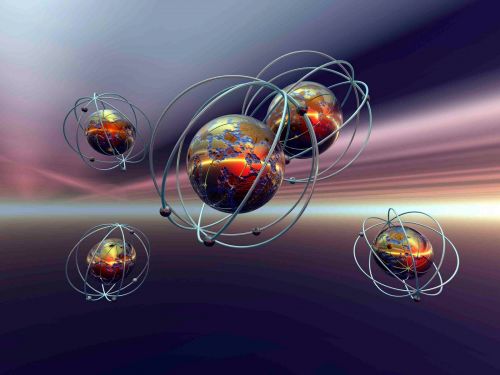Tiny SpecksA Poem by Rick Puetter...How small everything is!
Artist: Gaurav. Licensed under Creative Common Attribution-ShareAlike 3.0 Unported. The original image can be seen at http://lh5.ggpht.com/_qZgEIPGL3_M/Sshgbrqy3tI/AAAAAAAAEHA/9uxKw8ClUA0/quantumuniverse.jpg Tiny Specks “Everything is so small…” Oh, tiny speck of space and time1 Adrift in endless seas How large the world must seem to you-- Stretch to infinity! Oh, tiny speck of hadron2 soup How lonely you must be! No others near, as you're steeped in Dilute, electron sea Oh, tiny speck of iron3 and stone And blue with azure seas You are but dust--I smaller still You once seemed big to me And you’re ' speck, too--you isle of stars4 Pinwheel of heaven’s seas With telescope--not microscope-- For you, eye strains to see And tiny speck--you Universe5 Afloat yet greater seas! Oh yes, it's true! All things are small-- A wonderment to me ©2010 Richard Puetter All rights reserved Notes 1At the finest scales, space and time are quantized into a roiling sea of particles of space-time. These particles are of the smallest size and duration that make sense to talk about physically. They are the Planck time and Planck length, 5.39x10-44 seconds and 1.62x10-35 meters, respectively. 2Hadrons are particles, such as a protons and neutrons, that are made up of quarks and held together by the Strong Nuclear Force. So we’re talking about an atomic nucleus, here. If we assume we’re talking about a hydrogen atom, the proton has a roughly exponentially decaying charge distribution with an RMS radius of roughly 8.77x10-16 meters. The electron cloud surrounding it is roughly the size of the Bohr radius (5.29x10-11 meters), or roughly 100,000 times larger than the size of the nucleus. This is also about as close as another nucleus can come to another atom’s nucleus in a molecule as atomic bonds are of roughly this size. So a nucleus is alone and really sitting in a dilute sea of electrons. To keep track of our jumps in scale in this poem, a hydrogen atom is roughly 1024 times (a 1 followed by 24 zeros) larger than the finest division of space-time. 3The earth has a molten iron core. The earth’s radius is roughly 6.4x106 meters--the Earth is not perfectly spherical, the poles being flattened relative to the equator. So the Earth is roughly 1022 times bigger than a proton. 4The Milky Way galaxy, the home of our solar system, is a giant barred spiral galaxy, one of the largest kinds of galaxies. There is only one other giant spiral in the Local Group of 20 or so galaxies, and that is Andromeda. The rough radius of the Milky Way is 50,000 light years, or about 4.73x1020 meters. So it is about 1014 times bigger than the Earth. 5The Age of the Universe is now known (to 1% accuracy) to be 13.7 billion years old. So that also gives the size of the Universe to be 13.7 billion light years, or roughly 1.3x1026 meters, making it roughly 3x105 times larger than the Milky Way. So the size scale spanned in this poem is from the Planck length to the radius of the Universe or roughly a 1061 times change in scale. Now, of course, we’re not really done. Most physicists today believe the Universe is just a tiny “bubble” in some larger, multi-dimensional reality. How big is that? Well the question is not even really appropriate since we can’t even properly define what we mean by “size” on this “otherness” of existence. Our concepts simply fail. But if we could make some proper definitions, I am confident that we’d find our universe to be an incredibly small speck. © 2012 Rick PuetterFeatured Review
Reviews
|
StatsAuthorRick PuetterSan Diego, CAAboutSo what's the most important thing to say about myself? I guess the overarching aspect of my personality is that I am a scientist, an astrophysicist to be precise. Not that I am touting science.. more..Writing
|


 Flag Writing
Flag Writing